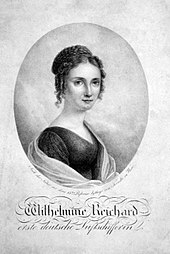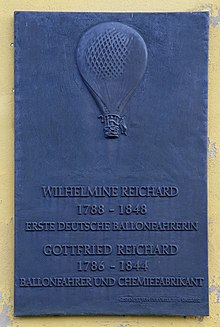Gottfried Reichard
Johann Carl Gottfried Reichard (born March 26, 1786 in Braunschweig ; † March 27, 1844 in Döhlen , Dresden office ) was a German chemist and balloonist . With his first ascent on May 27, 1810 in Berlin, he became the second German balloonist after Friedrich Wilhelm Jungius and as such undertook a total of 16 documented air voyages in the following years. As a chemist, he founded the early 1820s in what is now Freitaler district Döhlen one to 1,894 existing chemical plant and was as an industrialist in the exploitation of local coal reserves in Döhlen Basin involved.
His wife Wilhelmine Reichard (1788–1848) was the first German woman balloonist to become known and honored.
Life
Gottfried Reichard was born as the son of the commissioner and director of the porcelain factory Fürstenberg Philipp Urban Reichard († 1789). His mother was Eusebia Friederike Auguste, b. Gohl (1750-1824). His father died very early. Gottfried Reichard was only 3 years old. He attended school alternately in the Braunschweig Katharinenschule and in the Joachimsthaler Gymnasium in Berlin , where he had relatives. Although he wanted to study, he first learned to be a printer in his eldest brother's printing shop , but later studied chemistry in Berlin , albeit penniless .
Reichard as an aviation pioneer
In Berlin on May 23, 1804, he witnessed the unsuccessful balloon ascent of Professor Bourget at the Tiergarten , which at the time failed due to poor material. The teacher Friedrich Wilhelm Jungius (1771-1819) also attended this event and made his own attempt on September 16, 1805, making him the first German balloonist. Here, too, Reichard was an eyewitness again. Strongly impressed by these two events and inspired by the successes of the two French balloonists Jean-Pierre and Sophie Blanchard , Gottfried Reichard began planning and practical preparatory work for his own project in the same year, although initially for financial reasons and because of the Napoleonic wars failed.
After returning to Braunschweig in the meantime, he met Wilhelmine Schmidt , known as Minna, who shared his enthusiasm for balloon flights. They married on August 6th, 1806 in Braunschweig and finally moved to Berlin. Here Gottfried Reichard worked, among other things, as a private teacher and gave scientific experimental lectures. The small family, a daughter had already been born to the couple in Braunschweig, lived first on Heiligegeiststrasse, then on Rosenthaler Strasse . In Berlin, Reichard made personal acquaintance with Friedrich Wilhelm Jungius and the two soon became close friends. Thanks to the support and experience of Jungius, Reichard's first own gas balloon was created , with which he rose in Berlin on May 27, 1810 and thus went down in history as the second German balloonist. Minna, who a year later, on April 16, 1811, dared to take to the skies alone with a balloon, became the first German woman balloonist.
In 1811 the family moved to the Saxon residence city of Dresden , where they were able to inspire with balloon rides and experimental lectures and made the acquaintance of influential personalities. Reichard got a job in the Potschappel vitriol factory , which was destroyed some time later by armed conflicts.
In order to raise the financial means for their own chemical factory, the Reichard couple undertook further aviation trips. Between the years 1816 and 1820 there should have been around 22 air journeys. And in order not to disappoint the paying audience with up to 50,000 spectators, the two of them also accepted the weather conditions, which repeatedly brought the balloonists into life-threatening situations. Wilhelmine Reichard survived the crash of her balloon on September 30, 1811 during her third balloon flight with a lot of luck. In the same year Gottfried Reichard published a description of the work by Wilhelmine Reichard, geb. Schmidt, made a travel report about this event for the third time in the air , which started in Dresden and came to an abrupt but ultimately happy end near Saupsdorf in Saxon Switzerland .
After 17 air journeys, she ended her career in 1820. Her last flight took place on the occasion of the 10th Oktoberfest in Munich . 15 years later, Gottfried Reichard also undertook his last flight at the Oktoberfest in 1835 in the presence of the Bavarian King Ludwig I. Altogether there should have been 16 air journeys, of which he undertook the seventh on October 9, 1816 in the company of Count von Pückler-Muskau from Berlin. His eighth air voyage also started from Berlin on May 11, 1817, this time accompanied by his friend Friedrich Wilhelm Jungius, who died about two years later of a lung disease.
Reichard as an industrialist
Not least with the successful and in some cases quite well paid balloon rides, the Reichards were able to generate the financial means for their own chemical factory. They finally acquired their own property in Döhlen near the old factory facilities of the Potschappel vitriol factory in Plauenschen Grund . In 1814 the family initially moved into a rather shabby house and the following year the Reichards received the sovereign concession for a “factory of technical and pharmaceutical-chemical products” . The factory construction began six years later with financial support from the Saxon state government. In 1822 the production of concentrated sulfuric acid began . The product range also included fuming sulfuric acid , vitriol oil , nitric acid , hydrochloric acid , soda and other chemical supplies for dye works and printing works .
As an entrepreneur, Reichard participated in the development of the local hard coal industry , also in order to use the local hard coal deposits for his own factory. He was involved in the Meiselschacht coal mine, which opened in 1828 in the neighboring village of Gittersee . He was also the owner of coal fields in the Pesterwitz district . Otherwise he was very committed to society and a member of numerous associations such as the Dresden Trade Association, the Saxon Industry Association, the Economic Society in the Kingdom of Saxony and the Dresden Construction Association. And shortly before his death, he was a co-founder of the "Association for the Dissemination of Public Benefit Knowledge in Plauen Basin", of which he became chairman.
After his death in 1844, his wife Wilhelmine continued to run the company for four years until she too died. Wilhelmine Reichard had given birth to eight children to her husband and so the Reichard descendants were able to continue running the factory, which had meanwhile been converted into a stock corporation, for more than four decades. Most recently, Gottfried Reichard's grandson Otto Reichard headed the plant from 1874. He died in 1891 when he fell into a lead kettle filled with sulfuric acid. In 1894 the factory ceased operations for environmental reasons in exchange for compensation from surrounding communities and landowners.
Aviation Reichards (selection)
Gottfried Reichard probably undertook a total of 16 balloon trips. However, this number remains vague due to the lack of documentation. Shortly after Gottfried Reichard's death in 1846, the author Julius Petzholdt tried to make a corresponding list in Volume 22 of the biographical reference work Neuer Nekrolog der Deutschen :
| enumeration | date | place | Remarks |
|---|---|---|---|
| 1. | May 27, 1810 | Berlin | |
| 2. | September 9, 1810 | Wroclaw | |
| 3. | October 1810 | Wroclaw | |
| 4th | August 1811 | Braunschweig | |
| 5. | July 12, 1816 | Berlin | |
| 6th | September 16, 1816 | Hamburg | |
| 7th | October 9, 1816 | Berlin | Accompanied by Count Hermann von Pückler-Muskau . |
| 8th. | May 11, 1817 | Berlin | Accompanied by Friedrich Wilhelm Jungius. |
| 9. | July 25, 1817 | Poses | |
| 10. | July 27, 1817 | Poses | |
| 11. | August 17, 1817 | Warsaw | |
| 12. | September 1817 | Warsaw | |
| 13. | May 31, 1818 | Dresden | |
| 14th | Fall 1834 | Dresden | |
| 15th | October 1834 | Leipzig | |
| 16. | October 9, 1835 | Munich | Oktoberfest |
The Reichardhaus in Döhlen
The family home in Freitaler Reichardstrasse 9 named after them is now privately owned and is a cultural monument . The passionate balloonist Matthias Schütze acquired it at the end of the 1990s, when there were already plans to demolish this historic, but also more than just renovated and heavily damaged building. During the renovation work financially supported by the city of Freital, the historic half-timbering of the house was also exposed. Efforts are currently being made to use the Reichardhaus as a museum.
A memorial plaque donated by the local savings bank is attached to the Reichardhaus today .
Work (selection)
- Description of Wilhelmine Reichard, geb. Schmidt, undertook third air journey. Gärtner, Dresden 1811 (Archiv-Verlag, Braunschweig 1998).
Literature (selection)
- Julius Petzholdt: Message from the library of the trade association in Dresden: For the birthday party of Sr. Well Born of Prof. Johann Carl Gottfried Reichard…, Dresden, March 26th 1843
- Julius Petzholdt: "Johann Karl Gottfried Reichard" In: " New Nekrolog der Deutschen ", Voigt-Verlag, Weimar 1846, Volume 22, pp. 309 to 315
- Otto Krätz : “Emancipation in the clouds. From the poetic diary of an airship woman ”In:“ Culture & Technology ”, Issue 1/1979, pp. 40–45
Web links
- Juliane Puls: Reichard, Gottfried . In: Institute for Saxon History and Folklore (Ed.): Saxon Biography .
- Entry on Gottfried Reichard in the Stadtwiki Freital
Footnotes and individual references
- ↑ a b c d e f g h Juliane Puls: Reichard, Gottfried . In: Institute for Saxon History and Folklore (Ed.): Saxon Biography ., Accessed on December 29, 2019
- ↑ a b c d Otto Krätz: “Emancipation in the clouds. From the poetic diary of an airship woman ”in“ Culture & Technology ”, issue 1/1979, pp. 40–45 ( pdf )
- ↑ a b c d e f g J. Petzholdt: "Johann Karl Gottfried Reichard" In: " New Nekrolog der Deutschen ", Voigt-Verlag, Weimar 1846, Volume 22, pp. 309 to 315
- ^ Biography of Friedrich Wilhelm Jungius at www.epoche-napoleon.net, accessed on December 30, 2019
- ↑ Andreas Conrad: "Pioneer in the gondola" In: Tagesspiegel , April 15, 2011
- ^ A b Dorit Oehme: "Museum plans for the balloonist house" In: Sächsische Zeitung , September 22, 2017
- ↑ Literature and advertisement sheet for the building trade as a supplement to the Allgemeine Bauzeitung, December 1838, No. 15, pp. 136/137
- ↑ The Freitaler Reichardhaus on the city homepage, accessed on December 31, 2019
| personal data | |
|---|---|
| SURNAME | Reichard, Gottfried |
| ALTERNATIVE NAMES | Reichard, Johann Carl Gottfried; Reichard, Johann Karl Gottfried |
| BRIEF DESCRIPTION | German balloonist and chemist |
| DATE OF BIRTH | March 26, 1786 |
| PLACE OF BIRTH | Braunschweig |
| DATE OF DEATH | March 27, 1844 |
| Place of death | Döhlen |




